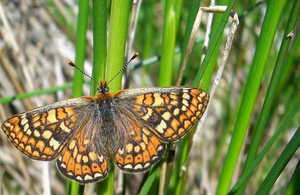Protection extended for mid Cornwall’s wildlife-rich landscape
Protection for rare birds and butterflies across mid Cornwall has increased.

Marsh fritillary butterfly © Natural England
Rare butterflies and birds will benefit from a much larger area of protected land in mid Cornwall from today, says Government wildlife adviser Natural England.
The new Mid Cornwall Moors site of special scientific interest (SSSI) merges the six original SSSIs which previously dotted the landscape either side of the A30 and east of Indian Queens, extending their boundaries and protecting around 50% more of the countryside. The SSSI includes several closely located patches of land, connecting important habitats and helping wildlife to withstand pressures from climate change in the future, creating a stronger refuge and network for rare plants and animals.
The countryside across the Mid Cornwall Moors is a rich and varied mix of heathland, woodland, and wildflower meadows; a vital sanctuary for wildlife, as well as an important asset for local people, visitors, and businesses. Fens and mires in the headwaters of the Fal and Par catchments also help to provide clean water and have the potential to reduce flood risk to homes and properties located further downstream.
Natural England has joined forces with landowners, the Cornwall Wildlife Trust and Butterfly Conservation, building on the successes of the Mid Cornwall Moors LIFE project to create the perfect conditions for the rare marsh fritillary butterfly, which should see its fortune improve as a result. The wet woodlands throughout the area are important for the diminutive willow tit, which has virtually disappeared from large parts of the UK and declined by an estimated 81% since the mid-1990s. The new areas added to the SSSI include important breeding sites for both of these special species.
The former A30 at Goss Moor was downgraded to recreational use for cyclists, horseriders and walkers in 2008. Natural England has been working with Highways England, the Eden Project and Butterfly Conservation to create new habitat areas for butterflies and other wildlife on land alongside the new A30 corridor, several of which have now also been included within the new SSSI boundary. With help from the Eden Project, swathes of devil’s-bit scabious flowers – the main food plant for the marsh fritillary butterfly – have been grown and planted alongside the A30.
Speaking at an event at the Eden Project today, Natural England’s Chief Executive James Cross said:
The Mid Cornwall Moors are incredibly important areas for wildlife as well as people, and balancing the needs of both are critical to their conservation. Today’s notification builds on the success of the LIFE project, providing protection for the much-improved breeding habitats for marsh fritillary butterflies along the A30 corridor - making it a valuable asset, not just for businesses and visitors – but also for wildlife. Mid Cornwall Moors is now one of our top wildlife sites and we are able to give it the protection it deserves.
Seán O’Hea, Mid Cornwall Reserves Manager, Cornwall Wildlife Trust said:
The Mid Cornwall Moors are special because of all of the patches of good quality wildlife habitat scattered across the landscape. This designation is very well thought out because it looks beyond the previous SSSI boundaries to consider what the wildlife really needs to thrive. It extends the protection given by SSSI status to many more important pieces of land, creating a wider network of protected sites.
Philip Hambly, Chairman of Cornwall Butterfly Conservation said:
The marsh fritillary is threatened, not only in the UK but across Europe. It is therefore essential that this rare butterfly is managed carefully and on a landscape scale so colonies remain connected. Mid Cornwall Moors protection as an SSSI will target conservation to help this butterfly’s survival across this very important area. Cornwall Butterfly Conservation’s volunteers have already worked in partnership with Natural England carrying out surveys and conservation work and very much look forward to continuing this together.
Dr Caroline Bulman, Head of Species Ecology at Butterfly Conservation, said:
Like many specialist butterflies, the threatened marsh fritillary can only survive when colonies are able to move between areas of suitable wet grassland - which provide the host plant and conditions for them to thrive. We welcome the expansion and changes to the new designation of the Mid Cornwall Moors SSSI, as this will help to protect this and other important species at a landscape-scale and help to reverse the decline, for such rapidly declining species.
The previous SSSIs now included within the Mid Cornwall Moors SSSI include Goss and Tregoss Moors, Red Moor, Retire Common, Breney Common, Tregonetha and Belowda Downs and Belowda Beacon. The area protected as a SSSI has increased by over two square miles and now covers areas totalling six and a half square miles across the wider Mid Cornwall Moors landscape.
The Mid Cornwall Moors SSSI comes into immediate effect from today, 23 February. Landowners, occupiers and interested parties have 4 months in which to make representations or objections to Natural England, who will then decide whether or not to confirm the notification.